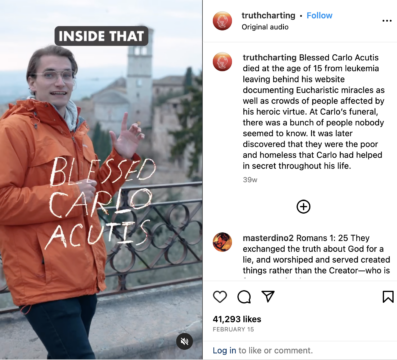It’s perhaps the most pressing question in the Church today: How can we better reach young people? They’re leaving the Church in droves, yet these same people spend hours scrolling through TikTok and Instagram. Could that be a place of contact? John Donahue thinks so. As the founder and content creator at Truth Charting, a Catholic media ministry focused on reaching Gen-Z, he’s found great success on TikTok and Instagram by highlighting the most exciting stories, truths, and movements of the Catholic Church.
Brandon Vogt recently sat down with John to discuss what he’s learned and how the Church can better use these platforms.
Tell us about your digital ministry, Truth Charting. How did it start, and what’s the aim?
The idea was officially conceived in 2020 through conversations with my Confirmation sponsor and my older brother. However, the seeds were planted much earlier than that. Since I was ten years old, I dreamed of being a YouTuber.
It started as one of those very common “Bro . . . we should start a podcast” ideas, but the Lord just infused so much grace and provision that here we are, three years later, and after a few pivots on that original idea, it’s now my full-time job.
The aim for Truth Charting is to create videos with the same high-octane format that young people see in their favorite secular online content, but infuse it with truth, beauty, and goodness. We want to prove that Catholicism is an even more adventurous and fulfilling lifestyle—which it is! I believe that very strongly; I will die on that hill.
What are some of your more popular videos?
Earlier this year, I got an opportunity to go to Italy. I took a train to Assisi and visited the tomb of Bl. Carlo Acutis. From the moment I first heard Bl. Carlo’s story, it had a big impact on me. I remember watching his beatification livestream and just weeping. As I sat next to his tomb in prayer, I was just so inspired by the type of guy he was, and it filled my heart with a desire to be like him. I asked for his intercession, and then I decided to make a video about him.
At this point, Truth Charting was about a year old and had gained very little traction. I was considering if I was really supposed to keep trying. But I got back home, edited the video, posted it, and it kind of blew up.
This was my first real taste of traction, and I can’t help but think back to the moment when I was sitting next to Carlo’s resting place asking for his intercession for Truth Charting.
Our most recent viral video was this one:
I can’t remember exactly when I first heard about the concept of using a lightspeed spacecraft and a really good telescope to see into the past. But apparently a lot of people on TikTok found it just as thought-provoking as I did.
The tagline of Truth Charting is: “The Catholic Faith is not boring.” Why do so many young people think it is? And how can we change that?
For most young Catholics, their only view of the Catholic Church is sitting in a classroom with fluorescent lights being told why they should care about their imminent Confirmation. In a lot of cases, this is happening right after these kids have already spent eight hours of their day sitting in a classroom with fluorescent lights at school. That’s way too much fluorescent light.
Let them go on a mission trip and climb a mountain (maybe fall and break their arm). Seriously. Go live the Catholic life. Being told about Catholicism can only get you so far. There’s a whole smorgasbord of Catholic experiences that they’re missing out on. They’re being told the concepts but not given the opportunity to experience the lifestyle.
There are a lot of ministries and youth programs that have been changing the perception that Catholicism is boring through in-person retreats and trips. The path we’ve taken with Truth Charting is to meet young Catholics where they are on the internet and expose them via online content to these awesome things going on within the real life of the Catholic Church.
If we want to be missionaries online, we need to learn the language of the mission territory.
Truth Charting has been massively successful on two platforms dominated by Gen-Zers, Instagram and TikTok. In your experience, what’s unique about this generation? What should we know about them?
I often use an analogy for the internet, particularly social media, as an island people go to rather than a tool people use. Gen-Z is the first generation that grew up on the island. Older generations began visiting it in their later teens or adulthood, but Gen-Z was actually raised on the island. On average, they spend more of their day on the island than they do in real life.
Just as other lands have distinct languages and accents, so does the digital island. Gen-Z has their own unique “accent” or “dialect.” I’ve felt maybe the Lord has called me to be not just a communicator but a translator on this island. Scholarly Catholic language is pretty much the exact opposite of Gen-Z internet language. If I were to try to explain the concept of theosis to Gen-Z over the internet, I would have to do so using a ton of visual aids and a whole lot of casual language. I’d also have to do it in under sixty seconds.
If we want to be missionaries online, we need to learn the language of the mission territory. That’s what we try to speak through Truth Charting.
I’m especially intrigued by TikTok, a platform many Catholic evangelists have yet to take seriously. What should we know about TikTok?
To be frank, TikTok is one of the more dangerous areas of the island. It’s hard to evangelize there. In my experience, you’ll get more savage comments, be more likely to fall into a doom scroll than other apps, and it’s very likely you’ll come across content that is bad for your soul. So I have to be really serious about safety measures on the app.
But as we know, there are millions of Gen-Zers who live on that app—that’s their island. And there were people who lived in Nineveh. We need Jonahs willing to go there.
What approaches seem to resonate most with Gen-Z, those born between the 1990s and early 2010s? What types of videos? What angles?
People really like to be invested in. When you go to a nondenominational church, you’ll almost inevitably see an expensive screen behind the stage. The service is high octane and engaging. The A/V team creates alluring visuals and experiences. They’ve clearly invested time into learning how to speak the language of their people.
Bracketing their theology, nondenominational churches like this are really appealing to Gen-Z. Young people feel heard, seen, and invested in when they enter into the church.

I use this methodology in my videos by trying to speak their language. I use punchy editing, animations, motion graphics, and high video quality, all of which appeal to Gen-Z viewers.
My hope is that the time and effort I invest into these Catholic TikTok videos might make viewers open to Catholicism, and eventually to see the investment that the Lord is ultimately offering them in the Holy Sacrifice of the Mass.
Interestingly, you’ve strategically chosen not to upload your videos on Facebook. Why not?
By and large, young people don’t like Facebook. They think Facebook is for their parents or, increasingly, for their grandparents.
This explains why young people are way more likely to view a video they’ve found themselves on TikTok rather than one forwarded from a parent or grandparent on Facebook. So, for the sake of Gen-Z-focused branding, and to increase the receptivity of our target audience, we’ve decided to sacrifice the benefits of Facebook views and stick with TikTok, Instagram, and YouTube.
We’ve discerned our goal is not to reach as many people as possible—if it were, we’d be on every platform available—but to reach the right people (Gen-Zers) most effectively.
What’s next for Truth Charting? What can we expect over the coming years?
God willing, Truth Charting will begin building a team of highly talented content creators and provide content even more frequently. I also hope that our ministry will raise the quality and entertainment value of other content creators in the same space. There’s lots more coming!

